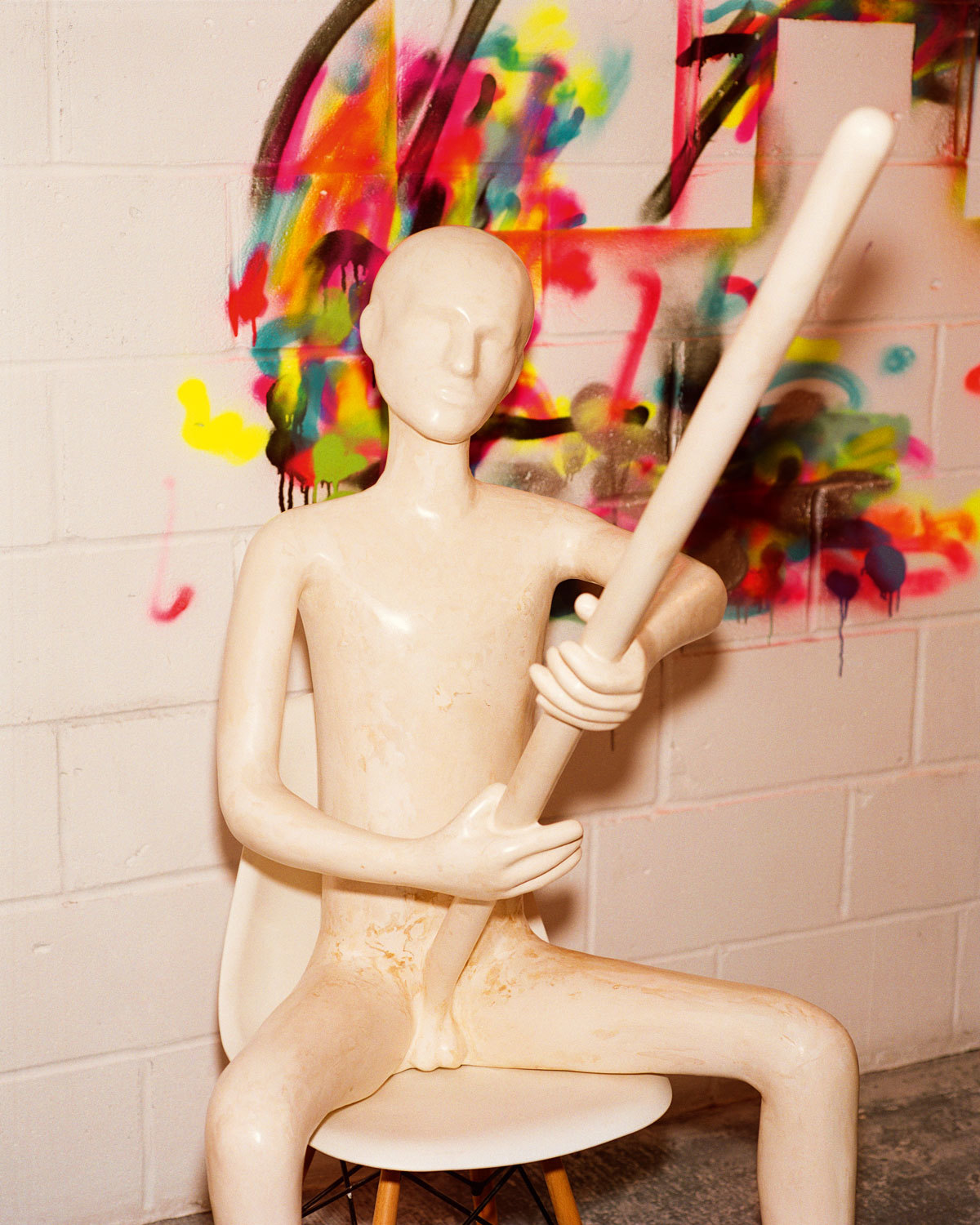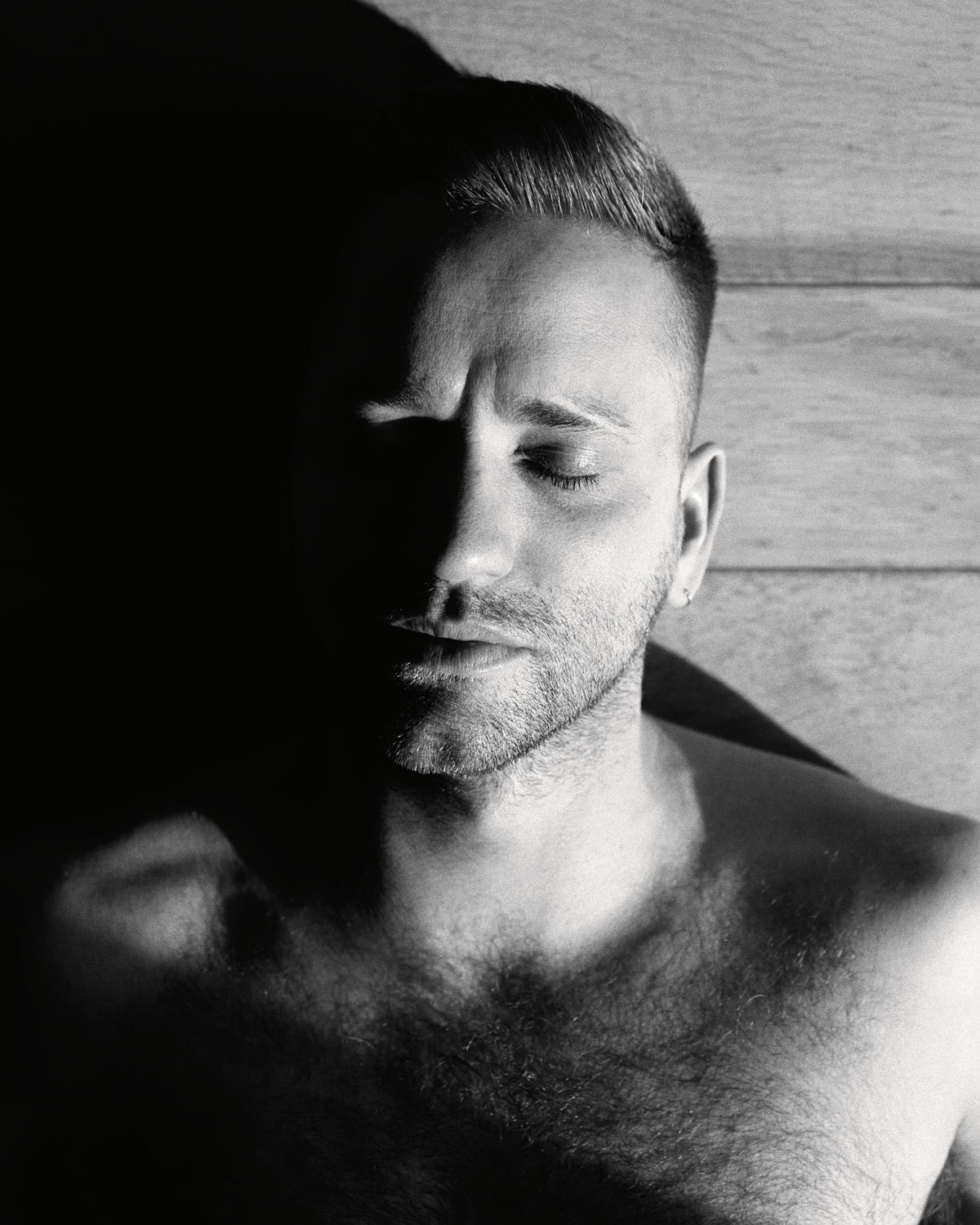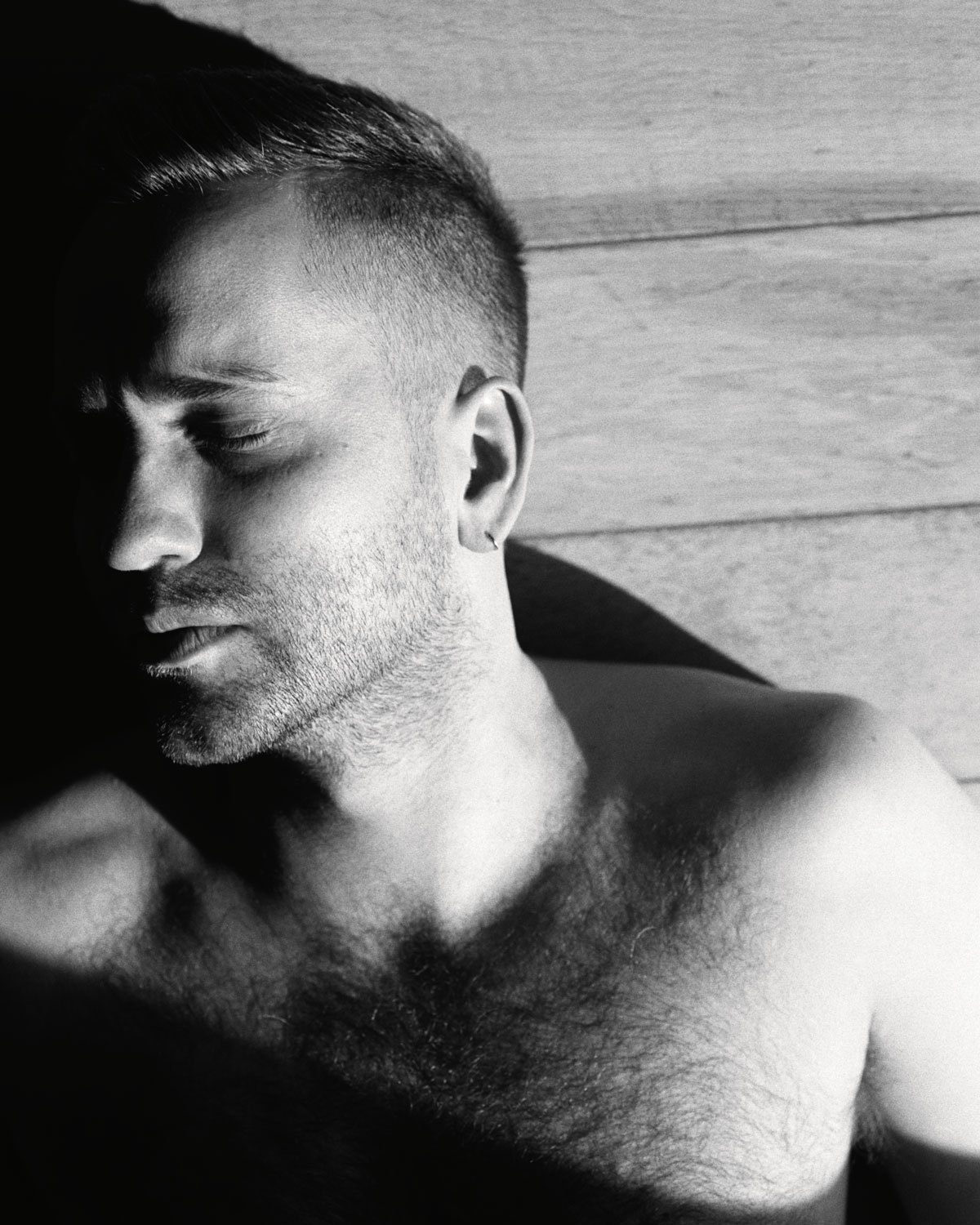Up against the wall of Eddie Peake’s Peckham studio sits a sculpture of a man on a chair, in between his hands is a giant, erect penis. It could stand as a cipher for all Eddie’s work: playful, ironic, erotic, laced with humor, surreal beauty, oddly earnest.
Eddie became an instant art world sensation with Touch, a naked, 5-a-side football match he staged at Royal Academy. Wearing nothing but boots and football socks, the participants played out that classic game of macho bravado. Unveiling the homo-erotic codes behind the ultimate spectacle of homo-social behavior, all that sweating, hugging, kissing, the only place its acceptable for men to cry and hug each other, reveling in making visible unspoken repression, making it playful, joyful, celebrating it, seems to be at the heart of Eddie’s work.
It’s been an exciting ride for the self-confessed shy show-off, whose one-and-only A-Level came in art. Born in north London, Eddie graduated from the Slade School of Fine Art in 2006, undertook a residency at the British School in Rome. He’s since taken his unique brand of art practice across the world, from Sao Paolo to Southend, The White Cube to Tate Modern. He’s worked with Kendrick Lamar, created a giant mural for Victoria Beckham’s Dover Street store, worked with pirate station Kool FM, runs a record label with The Vinyl Factory, and a club night, Anal House Meltdown, with fellow artists Prem Sahib and George Henry Longly. “I find it really exciting to make work that steps into a social sphere beyond that esoteric bubble,” Eddie says. “But I get a lot of stick for it whenever I do it.”

Most recently it’s taken him to the Barbican, for a new exhibition, The Forever Loop, which just closed. It was a watershed moment for the artist, the exhibition was backed up by a high-profile ad campaign, billboards decorated with his work were splashed across London, playing into his desire to have his work seen and engaged with beyond art’s inner circle. “I find the esoteric-ness of the contemporary art bubble really frustrating in its limitedness,” he says in his ordered little studio in Peckham. Eddie, despite being a hugely successful artist, isn’t immune from the current problems surrounding the sustainability of London’s creative sector, having been forced to leave his Hackney Wick base because of rising rents. And he’s got mixed emotions about such a big show closing. “There’s this sort of heightened frenzy of a show being on and very extreme feelings that come along with that,” he says. “The Barbican show was the culmination of ten years of exhibiting, so I have this weird array of feelings at the moment.”
The Forever Loop was an undoubted success, hitting a nerve with the public, a complex mix of video and text, performance and sculpture, large-scale immersive installation and intimate details. Through an elaborate looping performance of naked dancers, choreographed roller bladers, maze like sculptural installations, and aggressively florescent painting, Eddie Peake took viewers on a journey through many different types of desire. The public also met his two most lasting sculptural symbols, the bendy man (based on a scene in Who Framed Roger Rabbit? where the human Judge Doom is crushed by a steamroller, then emerges as a flat, wibbly-wobbly cartoon, and so existing “in this liminal space between different realities”) and the faun (“loosely based on Pan, the mythic creature, half-goat, half-man, very rampantly sexual, quite ambiguous, mischievous”). Sexual, ambiguous, mischievous, you can see why Eddie is so attracted to the faun.

There’s a distinctly mercurial quality surrounding Eddie’s sculptures. “I always think of T-1000 from Terminator 2,” he confesses. “I have my attraction to that type of materiality: marble-escent, hyper-fetishized, soft, perfect surfaces. Totally beguiling! I think there might be something psychopathic about it. It makes me think of American Psycho and that world where everything is perfect. In the film, Patrick Bateman brings out his business cards with his colleagues and says, ‘look at the embossing.’ Then he starts feeling sick as they bring out all of their business cards and there are all these little details that no-one would give a fuck about, but they’re totally masturbating over.”
When discussing Eddie’s work, it’s hard to avoid discussing nudity, sexuality and desire. The homepage of his website, which contains nothing else, is a photo of Eddie’s erect penis, bathed in delicate, rose light. For Eddie, nudity is natural and uninhibited. “But of course in our society it generally isn’t,” he says. Despite his fear of trashy, basic interpretations of the nudity in his work, he’s always drawn back to it, since it strips the body of period or culture, and also “refers to the history of art — an on-going wrestling match of mine, for example, with the poses of classical sculpture. This connection is more apparent when the dancers belong to the story of the nude in art.”

Sex and sexuality are big parts of Eddie’s wider projects too, notably gay night Anal House Meltdown. Because he has a girlfriend [fellow artist Celia Hempton], he’s been called out for cultural appropriation for working with Prem and George on the night, which started off in sweaty Dalston basement club Vogue Fabrics and has guested at The Glory and Corsica Studios. But thankfully Eddie isn’t cowed: “I love that Anal House Meltdown is a sexual space that I don’t 100% blend seamlessly into, but at the same time it’s my family.”
A friend of Eddie’s once described his work as part of “the post-caring generation.” Whilst he’s not keen on the term himself, he takes it on board. “I saw their point, because I don’t care if someone’s gay, straight, trans, bi or whatever,” he explains. “I genuinely don’t think that I’m straight, but similarly I don’t think I’m gay, bi, or trans. I always paraphrase Judith Butler in her book Gender Trouble, where she paraphrases Simone de Beauvoir: ‘there are as many sexualities in the world as there are people’. I like to imagine a world in which we didn’t have all these words to describe sexuality, so the conversation would be much more like, ‘I like really big dicks, this kinda size, sometimes I think about breasts, but not necessarily attached to women.’ Really subjective, really personal, and really detailed.”

Like most artists, Eddie’s not a huge fan of talking about his art, even though he’s actually rather good at it. He finds verbal language “completely clumsy and inadequate.” For Eddie, “art-making is a blind feeling-out in the dark.” When it’s suggested that his work captures the sensations, emotions, and ideas that he feels words can’t, he agrees. “I have a friend who’s tri-lingual and I asked her once, ‘what do you like best about being able to speak three languages?’ She replied, ‘Every language has words that are not literally translatable. So if you’re speaking certain words in another language, you’re literally having new thoughts.’ When I say in my art that I want to invent a language from scratch, I mean something like that: find a space and a place in the work that is untranslatable to any other form of language.”
Credits
Text Stuart Brumfitt
Photography Alasdair McLellan
Photography assistance Lex Kembery, Matthew Healy, Simon Mackinlay
Retouching Output LTD
